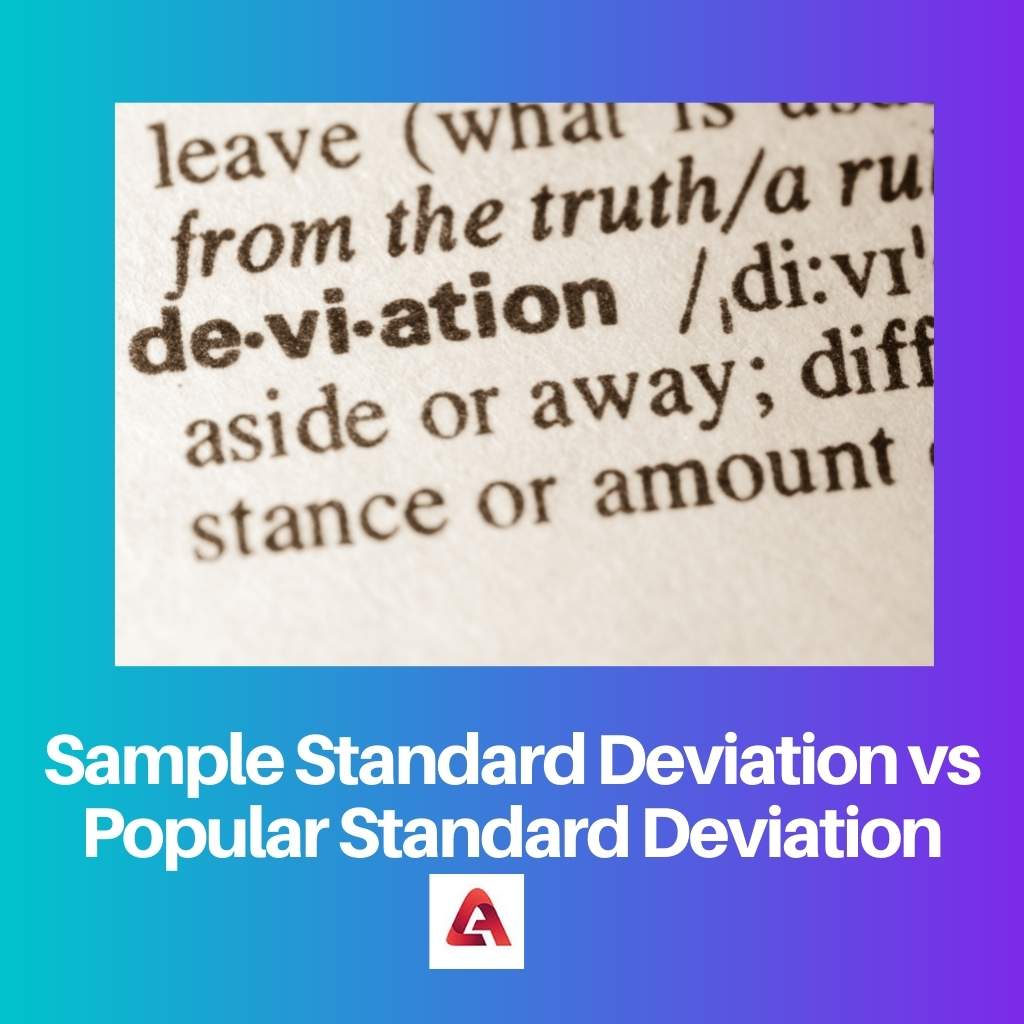One of the important topics that are taught in mathematics is Statistics. These kinds of problems are even taught in business schools as well.
This will help them in setting up their business. Standard deviation is a method that comes under statistics.
This standard deviation can be calculated with the help of two methods, such as sample standard deviation and the other one is the popular standard deviation.
Key Takeaways
- Sample standard deviation estimates the variability in a sample, while population standard deviation measures the variability within an entire population.
- Sample standard deviation uses the formula (Σ(xi – x̄)² / (n-1))^(1/2), while population standard deviation uses the formula (Σ(xi – μ)² / N)^(1/2).
- Using sample standard deviation can lead to a slightly biased estimate of the population standard deviation, whereas the population standard deviation provides the true measure of variability.
Sample Standard Deviation vs Popular Standard Deviation
The difference between Sample Standard Deviation and Population Standard Deviation is sample deviation uses only the random data to find the data distribution with the help of a given data set. On the other hand, population standard deviation uses population data to find the data distribution by a different formula.

Sample Standard deviation is a topic that is taught in mathematics. It is used mainly for finding the data that is distributed.
This type of deviation is calculated with the help of a formula. Along with the formula, you also need the values of some other terms to calculate it.
It even uses a special symbol to mention that term.
Population standard deviation is a method used in finding standard deviation. This kind of method uses a formula to find the answer.
Some steps are followed in this method to find the answer. Students will be able to study this at their school level.
But higher-level difficult problems will be taught in their higher studies, and they will be able to understand more.
Comparison Table
| Parameters of Comparison | Sample Standard Deviation | Population Standard Deviation |
|---|---|---|
| Big Problem | Yes | No |
| Formula | Yes | Yes |
| Used for | Determining the data distribution | It is for finding the value of data distribution |
| Sample | Random | Entire population |
| Data Set | Given | Given |
What is Sample Standard Deviation?
Sample Standard Deviation is a method that is used for measuring the data distribution. It is done with the formula.
This type of concept is used in maths. It comes under the topic of statistics. Students not only study this in school, but they also study this in their college.
No matter what kind of course they choose, if they have maths or some other statistical subjects, then this will come.
It is interesting and, at the same time, requires more time to solve the problem. If you use an Excel sheet to calculate, then it will help you to reduce some amount of time.
If you use a calculator to solve the sum, then it will take some time. Also, you have to enter the values very carefully. One small mistake will give you a wrong result in the end.
The other name of this standard deviation is called Sigma. It has a separate symbol to describe that.
To measure the sample standard deviation, you need to have original data. The data set will be given to you in advance.
But for calculating the standard deviation, you need to have the values of other terms. Then, only you will be able to calculate the sample standard deviation.
Even at times, it is also calculated along with the sample variance as well.
What is Population Standard Deviation?
Population standard deviation is a method that is used for finding the data distribution. To find this kind of standard deviation, you need to have a formula.
To calculate the population standard deviation, you need to follow the steps to solve the problem. The first step you need to follow is to find the mean of the given problem by calculating the given values.
All the data will be given in the problem itself. The second step you need to follow is to take the mean and subtract it from all the given data in the problem.
The third step you need to follow is to make all the values positive by squaring them. The fourth step is to add all the values that are squared.
The fifth step is to divide the values. The sixth step is to take the square root of the divided value.
This will give you the value of the population standard deviation.
This kind of problem is taught in statistics. There are different methods available for finding standard deviation.
And this is one such method used for finding the standard deviation. When you find the result of the population standard deviation, you can find that the result is equal to something, which is called the square root of the variance.
Main Differences Between Sample Standard Deviation and Population Standard Deviation
- We can use Sample Standard Deviation when the problem is big. On the other hand, population standard deviation can be used when the problem is small.
- Sample deviation is calculated with the help of random data. But population standard deviation is calculated with the help of population data.
- Sample deviation is calculated with the help of a formula. Likewise, population standard deviation also requires a formula to do the calculation.
- To calculate the sample standard deviation data set will be given. Likewise, population standard deviation is calculated with the help of a data set.
- Sample standard deviation is mainly used for finding the data distribution. Population deviation is also used for finding the data distribution value by a different formula.



